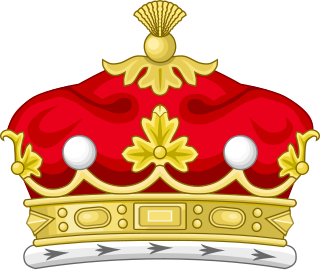| Earldom of Lisburne | |
|---|---|
  Arms: Sable, a Chevron between three Fleurs-de-lis Argent. Crest: An Arm in Armour embowed, holding in the hand a Sword, all proper. Supporters: Dexter: A Dragon reguardant wings elevated Vert, gorged with a Collar Sable, edged and charged with three Fleurs-de-lis Argent, affixed thereto a Chain Or; Sinister:A Unicorn reguardant Argent, armed maned tufted and unguled Or, gorged with a Collar Sable, edged and charged with three Fleurs-de-lis Argent, affixed thereto a Chain Or. [1] | |
| Creation date | 24 June 1776 |
| Created by | George III |
| Peerage | Peerage of Ireland |
| First holder | Wilmot Vaughan, 4th Viscount Lisburne |
| Present holder | David Vaughan, 9th Earl of Lisburne |
| Heir presumptive | Hon. Michael Vaughan |
| Remainder to | the 1st Earl's heirs male of the body lawfully begotten |
| Subsidiary titles | Viscount Lisburne Baron Fethard |
| Former seat(s) | Trawsgoed Mamhead House |
| Motto | NON REVERTAR INSULTUS (I will not return unavenged) |
Earl of Lisburne is a title in the Peerage of Ireland. It was created in 1776 for Wilmot Vaughan, 4th Viscount Lisburne. [2] He represented Cardiganshire and Berwick-upon-Tweed in the House of Commons and held minor governmental office. [3]
Contents
Not satisfied with the Irish title, Lisburne attempted to cajole his way into a title in the Peerage of Great Britain through his support of the Prime Minister the Duke of Portland. He quite unsuccessfully suggested in a letter that he would withdraw his support if he did not receive a peerage; Lisburne was horrified when his threat reached the ears of the king. "... his Majesty observed upon it that he could not have supposed that Lord Lisburne would have imagined that he was to be frightened into giving peerages—the moment was not open for explanation—your opinion, the declaration of your intentions, was in writing." [3]
His younger son, the third Earl, sat as Member of Parliament for Cardigan. He was succeeded by his son, the fourth Earl. He also represented Cardiganshire in Parliament. [1] His great-grandson, the seventh Earl, served as Lord Lieutenant of Cardiganshire. As of 2015 [update] the titles are held by the latter's grandson, the ninth Earl, who succeeded in 2014. [4]
The titles of Baron Fethard (or Baron Fethers), of Feathered in the County of Tipperary, and Viscount Lisburne, were created in the Peerage of Ireland in 1695 for John Vaughan, Member of Parliament for Cardiganshire and also Lord Lieutenant of that county. His son, the second Viscount, also represented Cardiganshire in Parliament and was Lord-Lieutenant of Cardiganshire. His younger brother, the third Viscount, was also Lord Lieutenant of Cardiganshire. He was succeeded by his son, the aforementioned fourth Viscount, who was created Earl of Lisburne in 1776. [5]
The heir apparent to the earldom uses the invented courtesy title Viscount Vaughan.
The family seat traditionally was Trawsgoed (Crosswood) in Ceredigion (Cardiganshire), Wales. [6] The Lisburne family still own a significant remaining acreage of the Trawsgoed Estate [7]






